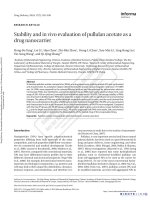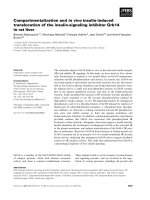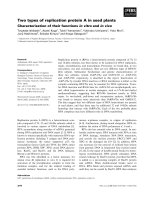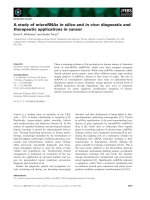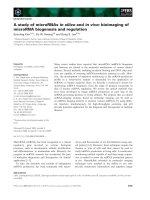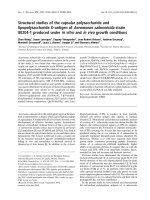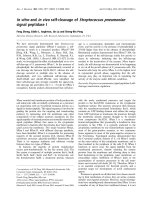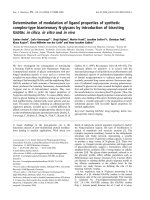Photoimmunotherapy of melanoma via combination of hypericin photodynamic therapy and in vivo stimulation of dendritic cells by PNGVL3 HFLEX plasmid DNA
Bạn đang xem bản rút gọn của tài liệu. Xem và tải ngay bản đầy đủ của tài liệu tại đây (1.37 MB, 130 trang )
PHOTOIMMUNOTHERAPY OF MELANOMA VIA
COMBINATION OF HYPERICIN-PHOTODYNAMIC THERAPY
AND IN VIVO STIMULATION OF DENDRITIC CELLS BY
PNGVL3-HFLEX PLASMID DNA
BRIAN GOH KIM POH
M.B.B.S. (S’PORE), M.R.C.S. (EDIN),
M.MED. (S’PORE), F.R.C.S. (EDIN)
A THESIS SUBMITTED
FOR THE DEGREE OF MASTERS OF SCIENCE
DEPARTMENT OF ANATOMY
YONG LOO LIN SCHOOL OF MEDICINE
NATIONAL UNIVERSITY OF SINGAPORE
2008
i
ACKNOWLEDGEMENTS
I would sincerely like to express my thanks and gratitude to my supervisor
Associate Professor Bay Boon Huat from the Department of Anatomy, National
University of Singapore for his guidance, advice, encouragement and most importantly
patience throughout the study period. I would also like to thank my co-supervisor
Professor Soo Khee Chee, Director of the National Cancer Centre Singapore for his
original and innovative ideas as well as critical comments for which this work would not
have been possible. My endeavour in the laboratory would not have been possible
without his support and encouragement. I am also deeply grateful to my co-supervisor
Associate Professor Malini Olivo, Principal Investigator of the Laboratory of
Photodynamic Diagnosis and Treatment, National Cancer Center for her essential and
invaluable support. Her expert advice and pivotal suggestions were critical for the
completion of this study.
I would like to express special thanks to Professor Hui Kam Man, Principle
Investigator of the Head, Division of Cellular and Molecular Research, National Cancer
Center Singapore for providing assistance and expert advice especially on the
immunological aspects of the study. He had also allowed me to use the research facilities
in his laboratory and provided us with many of the essential materials for this study.
I am deeply indebted to Ms Vanaja Tammilmani who has guided and assisted
me throughout my stint at the Laboratory of Photodynamic Diagnosis and Treatment,
National Cancer Center Singapore. She had sacrificed countless hours of her work and
personal time for this work. Also, I am grateful to all the other staff of the laboratory
including Ms Bhuvana Shridar, Ms Karen Yee, Mr William Chin, Dr Saw Lay Lay, Dr
ii
Du Hongyan, Dr Patricia Thong, Mr Koh Kiang Wei and Ms Saw Lay Lay for their
assistance and friendship.
I wish to express my appreciation to Associate Professor Wong Wai Keong,
Head of the Department of General Surgery, Singapore General Hospital and all
colleagues at the department for their understanding which allowed me the time to
complete this work.
Last but not least, I would like to thank Mr Aldon Tan who was a student from
Singapore Polytechnic whose tireless efforts and contributions to the work was
indispensable.
iii
TABLE OF CONTENTS
ACKNOWLEDGEMENTS………………………………………………………………i
TABLE OF CONTENTS………………………………………………………………...iii
SUMMARY………………………………………………………………………………vi
LIST OF FIGURES……………………………………………………………………...vii
LIST OF ABBREVIATIONS…………………………………………………………..viii
PUBLICATION/PRESENTATION………………………………………………………x
CHAPTER 1 INTRODUCTION………………………………………………………….1
1.1 Photodynamic Therapy (PDT)………………………………………………………...2
1.1.1
PDT-induced cell death…………………………………………………………2
1.1.2
PDT-induced immune response………………………………………………...4
1.1.3
PDT-generated anti-tumor vaccines……………………………………………8
1.2 Hypericin (HY)-mediated PDT………………………………………………………10
1.3 Immunotherapy with dendritic cells (DCs)…………………………………………..13
1.4 Photoimmunotherapy………………………………………………………………...22
1.5 Melanoma……………………………………………………………………………25
1.5.1 PDT for melanoma……………………………………………………………….27
1.5.2 Immunotherapy for melanoma…………………………………………………...30
1.5.3 Photoimmunotherapy for melanoma……………………………………………..32
1.6 Scope of study………………………………………………………………………..33
CHAPTER 2 MATERIALS AND METHODS…………………………………………35
iv
2.1 Cell Culture…………………………………………………………………………..36
2.2 Mice………………………………………………………………………………….36
2.3 Tumor model…………………………………………………………………………37
2.4 Photosensitizer……………………………………………………………………….37
2.5 Light source………………………………………………………………………….37
2.6 PDT-treatment of Tumors……………………………………………………………37
2.7 Plasmid DNA………………………………………………………………………...38
2.8 Transmission Electron Microscopy (TEM)………………………………………….38
2.9 In vivo experiments…………………………………………………………………..40
2.9.1 Effective PDT of B16 melanoma in C57BL/6 mice……………………………..40
2.9.2 Effect of mode of cell death after HY-PDT and if incubation period influenced the
mode of cell death………………………………………………………………..41
2.9.3 Growth curve of B16 and RMA tumor model…………………………………...41
2.9.4 Effect of photoimmunotherapy and PDT in a B16 primary tumor model……….42
2.9.5 Effectiveness of photoimmunotherapy in generating an anti-tumor vaccine……42
2.9.6 Effect of photoimmunotherapy on an established contralateral tumor (metastasis
model)……………………………………………………………………………43
2.9.7 Tumor specificity………………………………………………………………...43
2.9.8 Adoptive immune transfer……………………………………………………….44
2.10 Statistical analysis………………………………………………………………….44
CHAPTER 3 RESULTS…………………………………………………………………46
3.1 Effective PDT of B16 tumor…………………………………………………………47
v
3.2 Mode of tumor cell death after HY-PDT…………………………………………….49
3.3 Growth curve of B16 and RMA tumor model……………………………………….53
3.4 Effect of photoimmunotherapy and PDT in a B16 primary tumor model…………...55
3.5 Effectiveness of photoimmunotherapy in generating an anti-tumor vaccine………..60
3.6 Effect of photoimmunotherapy on a pre-established contralateral tumor (metastatic
model)………………………………………………………………………………..64
3.7 Tumor specificity…………………………………………………………………….67
3.8 Adoptive immune transfer…………………………………………………………...68
CHAPTER 4 DISCUSSION……………………………………………………………..70
4.1 PDT in melanoma……………………………………………………………………71
4.2 HY-PDT induced cell death………………………………………………………….72
4.3 Photoimmunotherapy with DC-based vaccines……………………………………...75
4.4 Effectiveness of photoimmunotherapy on primary tumor…………………………...78
4.5 Effectiveness of photoimmunotherapy in generating a tumor-specific anti-tumor
vaccine……………………………………………………………………………….79
4.6 Effect of photoimmunotherapy on a pre-established contralateral tumor (metastatic
model)………………………………………………………………………………..80
4.7 Adoptive transfer…………………………………………………………………….80
4.8 Conclusion…………………………………………………………………………...82
4.9 Future studies………………………………………………………………………...85
CHAPTER 5 REFERENCES……………………………………………………………88
vi
SUMMARY
Recently, combination treatment of photodynamic therapy (PDT) with dendritic
cell (DC)-based immunotherapy also termed photoimmunotherapy has been shown to be
an effective anti-tumor treatment. In these studies, the DCs were expanded in vitro and
primed in vivo via intratumoral injection of DCs. In the present study, the anti-tumor
effectiveness of a novel anti-cancer treatment via photoimmunotherapy uitilizing the
combination of hypericin (HY)-PDT and in vivo stimulation of DCs via pNGVL3-hFlex
plasmid DNA was investigated in murine B16 melanoma. The anti-tumor effectiveness
of PDT alone, photoimmunotherapy and control were compared in vivo in various murine
models including a primary tumor model, distant established tumor (metastatic) model
and
when
exposed
to
a
second
tumor
challenge
(tumor
vaccine
model).
Photoimmunotherapy was superior to both control and PDT alone in suppressing tumor
growth on a small established contralateral tumor and when exposed to a second tumor
challenge. However, it was not effective in suppressing the growth of a large established
contralateral tumor. Photoimmunotherapy was also not superior to PDT alone in
controlling the primary tumor.
In conclusion, photoimmunotherapy using HY-based PDT and in vivo DC
expansion by pNGVL3-Flex plasmid DNA is a novel anti-cancer modality which results
in an effective systemic tumor specific anti-tumor immune response which suppresses
tumor growth at distant sites.
vii
LIST OF FIGURES
Fig. 1 Structure of hypericin……………………………………………………………..11
Fig. 2A Photograph of female C57BL/6 mouse with established B16 tumor…………..47
Fig. 2B Photograph of female C57BL/6 demonstrating disintegrated tumor……………48
Fig. 3 Electron photomicrogram. Control: normal B16 tumor cells……………………..50
Fig. 4 Electron photomicrogram. B16 cells demonstrating features of necrosis after
PDT………………………………………………………………………………..51
Fig. 5 Electron photomicrogram. B16 cells demonstrating features of apoptosis……….52
Fig. 6 B16 growth curve…………………………………………………………………53
Fig. 7 RMA growth curve………………………………………………………………..54
Fig. 8 Group 1 vs 2……………………………………………………………………....56
Fig. 9 Group 3 vs 4………………………………………………………………………57
Fig. 10 Group 5 vs 6……………………………………………………………………..58
Fig. 11 Groups 1 & 2 vs 3& 4 vs 5 & 6………………………………………………….59
Fig. 12 Group 2 vs 3……………………………………………………………………..61
Fig. 13 Group 4 vs 5……………………………………………………………………..62
Fig. 14 Groups 1 vs 2 & 3 vs 4 & 5……………………………………………………...63
Fig. 15 Small metastasis. Groups 1 vs 2 vs 3……………………………………………65
Fig. 16 Large metastasis. Groups 4 vs 5 vs 6…………………………………………….66
Fig. 17 Effect of PDT, photommunotherapy and control of B16 tumor on RMA tumor..67
Fig. 18 Effect of adoptive transfer on B16………………………………………………68
Fig. 19 Effect of B16 adoptive transfer on RMA………………………………………..69
Fig. 20 Effect of photoimmunotherapy on B16 melanoma……………………………...84
viii
LIST OF ABBREVIATIONS
AJCC
American Joint Committee on Cancer
APC
antigen presenting cell
BCG
bacillus Calmette-Guerin
DC
dendritic cell
DMSO
dimethyl sulphoxide
DNA
deoxyribonucleic acid
FBS
fetal bovine serum
GMCSF
granulocyte-monocyte colony stimulating factor
HBSS
Hanks buffered salt solution
HSP
heat shock protein
IFN
interferon
IL
interleukin
IR
infrared
MHC
major histocompatibility
MIP
macrophage inflammatory protein
mRNA
messenger ribonucleic acid
NF
nuclear factor
NK
natural killer
PBS
phosphate buffer solution
PDT
photodynamic therapy
ROS
reactive oxygen species
RPMI
Roswell Park Memorial Institute
ix
SPG
schizophyllin
TAA
tumor associated antigen
TLR
toll-like receptor
TNF
tumor necrosis factor
UV
ultraviolet
x
PUBLICATION/PRESENTATION
1. Photoimmunotherapy of murine melanoma via combination of hypericinphotodynamic therapy and in vivo stimulation of dendritic cells by pNGVL3hFlex plasmid DNA. Oral presentation at the 10th World Congress of the
International Photodynamic Association (Munich) June 2005.
2. Goh BK, Olivo M, Manivasager V, Tan A, Hui KM, Bay BH, Soo KC.
Photoimmunotherapy of murine melanoma via combination of hypericinphotodynamic therapy and in vivo stimulation of dendritic cells by pNGVL3hFlex plasmid DNA. Submitted for publication.
1
CHAPTER 1
INTRODUCTION
2
1.1 Photodynamic Therapy (PDT)
Photodynamic therapy (PDT) is a clinically established physicochemical modality for the
local treatment of cancer (Korbelik and Sun, 2006). It is also presently utilized for the
treatment of various non-malignant diseases (Dougherty et al., 1998). Although light has
been used for the treatment of various diseases for over thousands of years, the
development of PDT as a therapeutic modality for human diseases has occurred only over
100 years ago (Daniell and Hill, 1991; Ackroyd et al., 2001; Moan and Peng, 2003). At
present, PDT has been advocated as a promising therapeutic modality for many human
cancers, and clinical trials testing its use are being performed for malignancies afflicting
almost any organ in the human body. Some of these include cancers involving the head
and neck region, brain, breast, lung, skin, liver, bile ducts, bladder and gastrointestinal
tract (Dougherty, 2002, Dolmans 2003). Currently, PDT is approved for use as curative
treatment for early-stage cancers and for palliation in advanced malignancies.
1.1.1 PDT-induced cell death
PDT induces both apoptotic and necrotic cell death. The balance between
apoptosis and necrosis after PDT in vitro depends on several factors including
photosensitizer concentration, light fluence rate, oxygen concentration and type of tumor
(Castano et al., 2005). Numerous in vivo and in vitro studies have been reported
examining the pathways of apoptosis induced after PDT. These studies have described
various signaling pathways, mitochondrial events and apoptotic mediators (Castano et al.,
2006; Agostinis et al., 2004; Moor, 2000). The mechanism of PDT’s tumoricidal effects
is a complex interplay of various biochemical processes in vivo. The 3 key components
3
considered essential for effective PDT are the presence of the photosensitizer, light and
oxygen. Briefly, PDT involves the systemic administration of a photosensitizer that
demonstrates preferential accumulation in tumor cells, followed by illumination of the
tumor with a laser beam. This generates a complex photochemical reaction which
produces cytotoxic intermediates such as reactive oxygen species (ROS) that can destroy
the tumor cells (Dougherty et al., 1998). Tumor destruction results not only from these
direct cytotoxic effects but also from the induction of a local inflammatory response
(Dougherty et al., 1998). The preferential accumulation of the photosensitizer in tumors
is a critical step in PDT. This process allows targeting of tumor tissue and reduces
damage to normal tissue (collateral damage). Although the mechanism of photosensitizer
retention in tumor compared to normal tissue has not been fully elucidated, a multitude of
factors have been proposed which contribute to this preferential distribution of
photosensitizers to tumor tissue. Changes in properties of the tumor tissues itself such as
decrease in pH, elevation of low density protein receptors, and presence of macrophages
may contribute to this preferential distribution. Other factors such as presence of a large
interstitial space, leaky vasculature, compromised lymphatic drainage, and high lipid
content have also been postulated to favor preferential distribution of photosensitizers to
tumor tissues (Dougherty et al., 1998).
Presently, it is believed that several biochemical processes contribute to the antitumor effects of PDT. Some of these key processes include: 1) direct tumor cell killing
induced by photooxidative damage, (Penning and Dubbelman, 1994) 2) vascular damage
and occlusion causing tumor cell damage via deprivation of oxygen and nutrients (Fingar,
1996) and 3) immune-mediated anti-tumor effects (de Vree et al., 1996; Korbelik et al.,
4
1996; Korbelik et al., 1997). The relative contribution of each of these mechanisms of
tumor destruction is difficult to determine but it is highly likely that all of these are
necessary for successful outcome after treatment (Jalili et al, 2004).
Direct tumor cell damage by oxygen free radicals is the main mechanism of tumor
cell killing via PDT. When the photosensitizer absorbs light, it is activated to an excited
singlet state. The activated photosensitizer is then rapidly converted to the longer-lived
triplet state due to intersystem crossing (Ryter and Tyrell, 1998). Eventually, the latter
can undergo two types of reactions. In type I mechanisms, a photosensitizer radical is
produced which in the presence of oxygen can generate superoxide radical anions,
peroxides and hydroxyl radicals (Ali and Olivo, 2003). Alternatively, in type II
mechanisms, singlet oxygen is produced by reaction of the triplet state of the
photosensitizer with oxygen.
Studies have demonstrated that vascular damage occurs after PDT which leads to
severe and persistent post-PDT tumor hypoxia and nutrient depletion which may
contribute to long-term tumor control. PDT has been shown to cause vessel constriction,
vessel leakage, thrombus formation and leukocyte adhesion leading to platelet activation
and thromboxane release which results in vessel damage and blood flow stasis (Fingar et
al., 1993; Fingar, 1996). Inhibition of nitric oxide production and release by PDT also
results in vasoconstriction (Gilissen et al., 1993). These PDT-induced changes in the
tumor results in microvascular damage and collapse leading to tumor cell destruction.
1.1.2 PDT-induced immune response
5
Besides the direct anti-tumor effects via ROS and ischemic tumor death via
vascular damage, there is accumulating evidence that PDT results in a strong anti-tumor
immune response. The anti-tumor immune response after PDT is composed of both the
non-tumor specific response secondary to the acute inflammatory reaction and tumorspecific immune reaction. After PDT, a wide range of photooxidative lesions produced in
the cytoplasm and membrane of tumor cells, tumor vasculature and surrounding stromal
elements results in the rapidly induced massive damage that threatens local homeostasis
(Korbelik and Sun, 2006). These result in a strong host response which aims to contain
the altered homeostasis, remove dead tissue and promote tissue healing of the affected
region (Korbelik and Cecic, 2003). This host reaction to PDT manifests as the
inflammatory reaction, immune response and acute phase response (Dougherty et al.,
1998). Various inflammatory mediators are released and expressed at the PDT treatment
site including heat shock proteins (HSP), cytokines, archidonic acid metabolites and
proteins from the complement system (Cecic and Korbelik, 2002; Gollnick et al., 2003;
Korbelik et al. 2005). Key components of the innate immune system such as Toll-like
receptors (TLR) and the complement system are activated and play a critical role in PDTmediated tumor destruction. Practically every component of the innate immune system
participate in tumor destruction including neutrophils, mast cells, macrophages, natural
killer cells and elements of the complement system such as opsonins and membrane
attack complex (Korbelik and Sun, 2006; Dougherty et al., 1998). Subsequently, the
activation of the innate immune system culminates in the development of the acquired
tumor specific immune response (Dougherty et al, 1998). Innate immune cell presence
and activation is essential for the development of acquired immunity and innate cell
6
infiltration into the treated tumor bed is a hallmark of PDT (Kousis et al., 2007;
Dougherty et al., 1998). The acute inflammation caused by PDT-induced tumor cell
necrosis attracts leucocytes to the tumor and increases antigen presentation. Heat shock
protein (HSP) 70 which is thought to be one of the most important cellular factors
involved in PDT-induced immune response is released and is involved in various
interactions with antigen presenting cells (APCs) including dendritic cells (DCs).
Tumor-specific immune response has been shown to be an important mechanism
in PDT-induced tumor destruction. There are numerous preclinical studies that suggest
that PDT enhances the systemic anti-tumor immune response although the mechanism
behind this enhancement remains unclear (Castano et al., 2006). Dougherty et al pointed
out that the tumor specific immune response may not be important in initial tumor cell
damage but its effect may be essential in maintaining long-term tumor control
(Dougherty et al., 1998). APCs such as DCs, macrophages and B lymphocytes are
important mediators in the initial step of tumor-specific immune response. Cancer cells
damaged or destroyed by PDT are processed by APCs and the antigens are presented on
the cell membranes via major histocompatibility (MHC) class molecules. These tumor
antigens are recognized by T helper lymphocytes which are than activated and
subsequently sensitize cytotoxic T lymphocytes to the tumor antigens. The activation,
expansion and differentiation of T lymphocytes lead to the development of tumorspecific immunity. These tumor sensitized lymphocytes have the potential to eliminate
disseminated tumor cells. Thus, PDT may be associated with a systemic immune reaction
and anti-tumor effect although PDT by itself is by definition a local therapeutic modality.
7
The findings of several studies that lymphoid cells are essential for preventing the
recurrence of PDT-treated tumors provide further support for the role of the tumorspecific anti-tumor immune reaction in PDT. Korbelik et al documented that PDTmediated curability of mouse cancers was reduced or non-existent in severe combined
immune deficient mice (Korbelik and Dougherty, 1999; Korbelik et al., 1999). This could
be restored after bone marrow transplant or T-cell transfer from immunocompetent mice.
Furthermore, immune memory cells could be recovered from distant lymphoid sites
suggesting that long-lasting systemic immunity was raised against even poorly
immunogenic tumors (Korbelik and Dougherty, 1999; Korbelik et al., 1999). HendrzakHenion et al., 1999 also demonstrated that after PDT treatment, immune-deficient mice
could not demonstrate complete tumor remission as opposed to immune-competent mice
which were permanently cured.
The results of these studies suggest that PDT can
generate immune memory cells and thus has the potential to be combined with
immunotherapy protocols in the treatment of malignant tumors. This potential has since
been confirmed by several studies which have demonstrated that immune-stimulating
cytokines, immunomodulators and adoptive transfer of immune cells have the ability to
enhance the anti-tumor effectiveness of PDT (Golab et al., 2000; Krosl et al., 1996;
Korbelik et al., 2001). Further evidence of the anti-tumor immune effects of PDT were
the observations in some studies that localized therapy with PDT was capable of
controlling distant disease (Gomer et al., 1987). In the recent study by Kabingu et al.,
2007, the investigators found that PDT-treatment of subcutaneous tumors resulted in
inhibition of the growth of distant lung metastases. This study was the first to
demonstrate that CD8+ T cell was responsible for the control of tumors growing outside
8
the treatment field following PDT. Earlier studies showing inhibition of distant tumor
growth away from the treatment field did not attempt to determine the specific effector
cell-type responsible for tumor control (Gomer et al., 1987; Blank et al, 2001). CD8+ T
lymphocyte mediated control of the distant lung tumors was found to be independent of
CD4+ T lymphocytes but dependent on natural killer (NK) cells (Kabingu et al., 2007).
These results were consistent with the earlier findings of Korbelik and Dougherty, 1999
whereby depletion of CD8+ T cells substantially impaired the ability of PDT to suppress
the long-term growth of EMT6 as opposed to the depletion of CD4+ T cells. Anecdotal
clinical cases of regression of distant tumors after local PDT have also been reported in
the literature (Thong et al., 2007; Naylor et al., 2006). Thong et al. reported an interesting
case of a histologically-proven multifocal cutaneous angiosarcoma of the head and neck
region. The patient underwent localized Fotolon-PDT of several selected lesions (Thong
et al., 2007). Spontaneous regression was subsequently observed in several of the
cutaneous lesions at distant sites. Biopsies demonstrated that these distant lesions were
infiltrated by CD8+ T-cell clones which suggest that PDT resulted in a systemic acquired
immune response which resulted in the systemic anti-tumor activity.
1.1.3 PDT-generated anti-tumor vaccines
In 2002, Gollnick et al., 2002 performed the first study to directly demonstrate the ability
of PDT to enhance tumor immunogenicity and to generate an effective anti-tumor
vaccine. They demonstrated that PDT-generated cell lysates were immunogenic and
PDT-generated vaccines were more effective than ultraviolet (UV) or ionizing radiationgenerated vaccines. These vaccines were tumor-specific, induced a cytotoxic T-cell
9
response and did not require the co-administration of an adjuvant to be effective. PDTgenerated lysates were shown to activate DCs to express interleukin (IL)-12 which is
critical in inducing a cytotoxic T-cell response. This capacity of PDT to stimulate both
phenotypic and functional maturation of DCs was postulated to be the key reason behind
the effectiveness of PDT in generating an effective anti-tumor vaccine. Subsequently,
their findings were confirmed more recently by Korbelik and Sun, 2006. In a similar
study, Korbelik and Sun, 2006 demonstrated that PDT-generated vaccines were
significantly superior to vaccines generated by lysed cells or X-ray treated cells in
producing tumor growth retardation, tumor regression and even complete tumor cures.
This study further confirmed the unique advantage of PDT for the generation of antitumor vaccines. Moreover, the PDT-generated vaccines were tumor-specific as
documented by its lack of efficacy against mismatched tumors. This finding was a firm
indication that the observed anti-tumor effects were due to a PDT-induced tumor-specific
immune response. It also further demonstrated that vital components of the tumorspecific immune response such as DCs, memory T- and memory B-cells were
dramatically increased at the tumor site and its draining nodes. Korbelik and Sun, 2006
also demonstrated that vaccine cells retrieved from the treatment site 1 hour after
injection were intermixed with DCs, expressed HSP70 on their surface and were
opsonized by complement C3 verifying the findings of several earlier studies (Castano et
al., 2006). More recently, Kousis et al., 2007 demonstrated that the induction of the antitumor immune response after PDT is dependent on neutrophil infiltration into the treated
tumor bed. They further suggested that neutrophils may be responsible for directly
10
stimulating T-cell proliferation and/or survival. However, these did not seem to affect DC
maturation or T-cell migration.
Unlike PDT, most of the routinely used anti-cancer therapies cause
immunosuppression. Radiotherapy and chemotherapy delivered at doses sufficient to
produce tumor destruction are well-known to be toxic to the bone marrow which results
in myelosuppression and hence, immunosuppression (Castano, et al., 2006). Nonetheless,
it is important to note that low doses of radiotherapy and chemotherapy may enhance the
immune system including induction of HSPs (Sierra-Rivera et al., 1993). Major surgery
has also been reported to produce immunosuppression, leading to diminished lymphocyte
and natural (NK) cell function (Ng et al., 2005). Hence, unlike these traditionally
available therapeutic modalities, PDT has the properties of an ideal cancer therapy which
not only results in primary tumor destruction but also triggers the immune system to
recognize and destroy remaining tumor cells which may be local or distant (Castano et
al., 2006).
1.2 Hypericin (HY)-mediated PDT.
The ideal photosensitizer for PDT should have the following properties including:
chemical purity, minimal dark toxicity, significant light absorption at wavelengths that
penetrate tissue deeply, high tumor selectivity and rapid clearance from normal tissue
(Ali and Olivo, 2003; Pass, 1993; Fisher et al., 1995). Various photosensitizers have been
approved and are currently used for the clinical treatment of cancer. These include
Metvix (5-aminiolevulinic acid- methylesther), Foscan (meta-tetrahydroxyphenylchlorin)
and Photofrin (Hematoporphyrin derivative). The most commonly used photosensitizer
11
presently is probably Photofrin. However, this first generation photosenstizer has several
notable limitations including the low light absorption, low tumor tissue selectivity and
long duration of cutaneous photosensitivity (Dolmans et al., 2003). This has led
researchers search for newer improved drugs with properties closer to that of an ideal
photosensitizer.
HY is a chemical found in the Hypericum species of herb of which hypericum
perforatum or St John’s Wort is the most common genum. It is a herb with golden yellow
flowers (Lavie et al, 1995). The proto-forms of HY and its congener pseudo-hypericin
exist as dark-coloured granules in minute glands of St John’s Wort (Southwell and
Bourke, 2001). These structures of partially cyclic precursors are transformed into
naphthodianthrone analogues; HY and pseudoHY on light irradiation. The chemical
structure of HY is demonstrated in Figure 1.
Figure 1. Chemical structure of HY
12
Under physiological conditions, HY is present as a monobasic salt. It can be taken
up by cellular lipid membrane structures and behave as lipophilic ion pairs (Lavie, et al,
1995). HY exhibits bright fluorescence detection in organic solvent, which makes it an
ideal diagnostic tool for fluorescence detection (Olivo et al, 2003). The utility of intravesical instillation of HY for the detection of flat bladder neoplasms have been
demonstrated in a clinical trial (D’Hallewin et al, 2002). HY is a powerful photosensitizer
as it demonstrates a high yield of singlet oxygen and its minimal dark toxicity makes it a
very promising and useful clinical tool (Agostinis, 2002). It is metabolized rapidly in vivo
and has minimal toxic properties when administered sytemically (Meruelo et al., 1988).
In vivo studies have demonstrated that HY binds well to tumor cells and are retained for
longer periods than normal tissues (Chung et al., 1984). HY has been studied in several
clinical trials for the treatment of skin cancers, brain tumors and cutaneous lymphoma
(Alecu et al., 1998, Lavie et al., 2000). However, its use has never been evaluated in
malignant melanoma.
HY has an extremely broad absorption spectra making it readily excitable by a
variety of light sources (Miller et al., 1995; Schempp et al., 1999) It is maximally
activated at a wavelength of light of approximately 470 nm (Ali and Olivo, 2003). The
photodynamic effects of HY have been well-investigated by numerous investigators. It
has been shown that high PDT doses induce rapid cell necrosis whereas lower
intermediate doses induce apoptosis (Agostinis et al., 2002, Ali et al., 2001). The
apoptotic pathway of cell death after HY-PDT has been well-elucidated. This has been
shown to be mediated by the mitochondria followed by activation of the caspase cascade
(Ali et al., 2001) possibly via hydrogen peroxide production (Ali et al., 2002). Assefa et
13
al. demonstrated that activation of c-Jun N-terminal kinase (also known as stress
activated protein kinase) and p38 mitogen-activated protein kinase increases the
resistance to HY-induced apoptosis (Assefa et al., 1999; Hendrickx et al., 2003). Other
effects of HY-PDT reported include activation of lipid peroxidation (Chaloupka et al.,
1999; Miccoli et al., 1998), inhibition of protein kinase C, inhibition of growth factor
stimulated protein kinase (Agostinis et al., 1995; de Witte et al., 1993) and increase in
matrix metalloproteinase-1 (Du, et al., 2004). In NPC/HK1 nasopharyngeal carcinoma
cells, it has been shown that HY-PDT produced maximal tumor regression in mice when
the incubation period was 1 hour and 6 hours after instillation of HY whereas HY-PDT
was less effective when incubation periods were between this time interval (Du et al.,
2003). Du et al., 2003 further demonstrated that at an incubation of 1 hour the HY
concentration was maximal in the mouse plasma whereas at an incubation of 6 hours, HY
concentration was maximal in the tumor tissue and low in plasma. Hence it was
postulated that HY-PDT could induce tumor necrosis and shrinkage via 2 mechanisms ie.
via vascular damage and direct tumor cell killing.
It is essential to note that different cell types may demonstrate a different response
to HY-PDT (Kyriakis, 1999; Lavie et al., 1999). It is well-known that the mechanism of
tumor destruction by HY-PDT hinges on several important factors including type of
tumor cell, tumor microvasculature, host inflammatory response and host immune
response (Dougherty et al., 1998).
1.3 Immunotherapy with DCs
14
Protective immunity results from the combined action of the innate and adaptive
immune system (O’Neill and Bhardwaj, 2007). The innate arm of the immune system is
composed of phagocytic cells, NK cells and complement which provide an early and
rapid non-specific immune response. Both B and T cells make up the adaptive immune
system which is critical for the generation of immunologic memory. Proper functioning
of both the innate and adaptive immunity is critical against the development of malignant
tumors (Smyth et al, 2006). APCs provide an important link between the two arms of the
immune system. They process intra- and extra-cellular proteins into antigenic peptides
which are then presented to cells of the adaptive immune system. Although, B cells,
macrophages, monocytes and DCs can all function as APCs, DCs are thought to be the
most potent APC of them all (Banchereau, et al, 2000). This has been demonstrated by
both in vitro and in vivo experiments (Steinman and Pope, 2002).
As with other APCs, DCs play an important role in activating both the innate and
adaptive components of the immune system via interaction with naïve T-cells (Steinman,
1997). DCs drive both the cell-mediated and humoral arms of the adaptive immune
response. They express high levels of major histocompatibility (MHC) molecules and
immune co-stimulatory accessory molecules and are responsible for the secretion of
many potent T-cell-activating cytokines which are critical for an effective immune
response (Fong and Hui, 2002). DCs specialize in acquiring, processing and presenting
antigens to naive, resting T-cells activating them to induce an antigen-specific immune
response (Banchereau et al., 1998). The process of efficiently capturing antigens is
restricted to the immature stage of development when DCs express low levels of MHC
and co-stimulatory molecules. During this immature stage, DCs are inefficient APCs.
